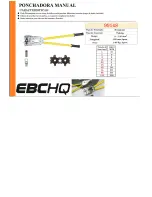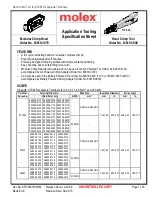
General safety notes
m
m
CAUTION:
Read all safety regulations and instruc-
tions.
Any failures made in following the safety
regulations and instructions may result in an
electric shock, fire and/or serious injury.
Keep all safety regulations and instructions in
a safe place for future use.
The term “electric tool” used in the safety ins
-
tructions refers to electric tools operated from
the mains power supply (with a power cable)
and to battery operated electric tools (without
a power cable).
1. Workplace safety
•
Keep your work area clean and well illu
-
minated. Untidy or unlit work areas can
result in accidents.
•
Do not operate the electric tool in an
environment where there is a risk of ex
-
plosions and where there are inflamma
-
ble liquids, gases or dust. Electric tools
produce sparks which could set the dust
or vapours alight.
•
Keep the electric tool out of the reach of
children and other persons. If there is a
distraction, you may lose control of the
appliance.
2. Electrical safety
•
The connector plug from this electric tool
must fit into the socket. The plug should
never be altered in any way. Never use
adapter plugs together with earthed elec-
tric tools. Unaltered plugs and correct
sockets reduce the risk of an electric
shock.
•
Avoid bodily contact with earthed
surfaces such as pipes, heating, ovens
and fridges. The risk of electric shock is
increased if your body is earthed.
•
Keep the tool out of the rain and away
from moisture. The ingress of water into
an electric tool increases the risk of an
electric shock.
•
Do not use the cable to carry the electric
tool, to hang it up or to pull it out of the
socket. Keep the cable away from heat,
oil, sharp edges and moving parts of the
appliance. Damaged or entangled cables
increase the risk of an electric shock.
•
If you are working outdoors with an elec
-
tric tool, only use extension cables which
are designed specifically for this purpose.
Using specially designed outdoor exten
-
sion cables, the risk of electric shock is
reduced.
•
If operation of the electric tool in a damp
environment can not be avoided, use a
earthleakage circuit-breaker. The earth-
leakage circuit-breaker reduces the risk of
an electric shock.
3. Safety of persons
•
Be careful, watch what you are doing
and use an electric tool sensibly. Do not
use the tool if you are tired or under the
influence of drugs, alcohol or medication.
A moment of inattention when using the
electric tool can result in serious injuries.
•
Wear personal protection equipment and
always wear safety goggles. Wearing
personal protection (such as dust masks,
non-slip safety shoes, safety helmet or
ear protection, depending upon the type
and use of the electric tool) reduces the
risk of injury.
•
Make sure that the appliance cannot start
up accidentally. Ensure that the electric
tool is switched off before you connect
it to the power supply and/or insert the
battery, or pick up or carry the tool. If
your finger is on the switch whilst carrying
the electric tool or if you connect the ap
-
pliance to the mains when it is switched
on, this can lead to accidents.
•
Remove keys and wrenches before swit
-
ching on the electric tool. A tool or key
which comes into contact with rotating
parts of the appliance can lead to injuries.
•
Avoid abnormal working postures. Make
sure you stand squarely and keep your
balance at all times. In this way, you can
control the electric tool better in unexpec
-
ted circumstances.
•
Wear suitable work clothes. Do not wear
loose clothing or jewellery. Keep hair, clo
-
thes and gloves away from moving parts.
Loose clothing, jewellery or long hair can
get trapped in moving parts.
•
If vacuuming devices and draining de
-
vices can be fitted, make sure that these
are correctly attached and correctly used.
The use of a dust extraction system can
reduce the danger posed by dust.
4. Usage and treatment of the electric tool
•
Do not overload the appliance. Use the
correct tool for your work. You will be
able to work better and more safely within
the given performance boundaries.
•
Do not use an electric tool with a defecti-
ve switch. An electric tool that cannot be
switched on or off is dangerous and must
be repaired.
•
Pull the plug out of the socket and/or
remove the battery before making any
adjustments to the appliance, changing
accessories or put the appliance down.
This safety measure prevents starting the
electric tool unintentionally.
•
Keep unused electric tools out of the
reach of children. Do not allow people
who are not familiar with the appliance
or who have not read these instructions
to use the appliance. Electric tools are
dangerous if they are used by inexperi
-
enced people.
•
Clean your electric tool carefully. Check
whether moving parts are functioning
properly and not jamming, whether parts
are broken or damaged enough that the
functioning of this electric tool is affected.
Have damaged parts repaired before
using the appliance. Many accidents are
caused by badly maintained electric tools.
•
Keep your cutting tools sharp and clean.
Carefully maintained cutting tools with
sharp cutting edges will jam less and are
easier to control.
•
Make sure to use electric tools, accesso-
ries, attachments, etc. in accordance with
these instructions. Take the conditions
in your work area and the job in hand
into account. Using electric tools for any
purpose other than the one for which
they are intended can lead to dangerous
situations.
5. Using and handling the cordless tool
•
Ensure that the tool is switched off before
you insert the battery. Inserting a battery
into an electric tool that is switched on
can cause accidents.
•
Only charge the batteries in chargers that
are recommended by the manufacturer.
A charger that is designed for a certain
type of battery may pose a fire risk if it is
used with other types of battery.
•
Use only the correct batteries in the elec
-
tric tools. The use of other batteries may
result in injuries and a fire risk.
•
Keep unused batteries away from paper
clips, coins, keys, nails, screws and other
metallic objects that could cause a short
circuit between the contacts. A short
circuit between the battery contacts may
cause burns or a fire.
•
In case of incorrect use, fluid may escape
from the battery. Avoid contact with it. If
you touch it by accident, rinse the affec
-
ted area with water. If you get the fluid
in your eyes, also seek medical advice.
Leaking battery fluid can cause skin irrita
-
tion or burns.
6. Service
•
Have your electric tool repaired only by
trained personnel using only genuine spa
-
re parts. This will ensure that your electric
tool remains safe to use.
Additional safety instructions
We pay a great deal of attention to the design
of every battery pack to ensure that we supply
you with batteries which feature maximum
power density, durability and safety. The bat
-
tery cells have a wide range of safety devices.
Each individual cell is initially formatted and its
electrical characteristic curves are recorded.
These data are then used exclusively to be
able to assemble the best possible battery
packs.
Despite all the safety precautions, caution
must always be exercised when handling bat
-
teries. The following points must be obeyed at
all times to ensure safe use. Safe use can only
be guaranteed if undamaged cells are used.
Incorrect handling can cause cell damage.
Important: Analyses confirm that incorrect
use and poor care are the main causes of
the damage caused by high performance
batteries.
Information about the battery
1.
The battery pack supplied with your cord
-
less tool is not charged. The battery pack
has to be charged before you use the tool
for the first time.
2.
For optimum battery performance avoid
low discharge cycles. Charge the battery
pack frequently.
3.
Store the battery pack in a cool place,
ideally at 15°C and charged to at least
40%.
4.
Lithium-ion batteries are subject to a
natural ageing process. The battery pack
must be replaced at the latest when its
capacity falls to just 80% of its capacity
when new. Weakened cells in an aged
battery pack are no longer capable of
meeting the high power requirements and
therefore pose a safety risk.
GB
11
Summary of Contents for 5909204900
Page 2: ...2 ...
Page 3: ...Fig 1 1 2 3 5 4 3 ...












































